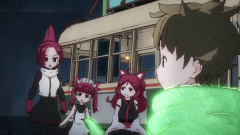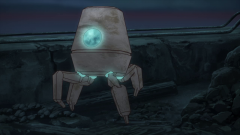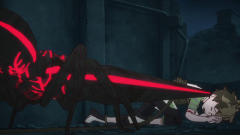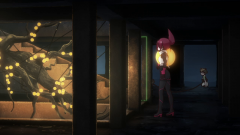I’m glad that the girls (FYI, their names are: Rin our main girl, Ritsu the oldest cat-ears girl, and Rina the quadruplet) decide to explore to other islands because the world building of Kemurikusa is easily its biggest strength right now. I also appreciate the fact that the show doesn’t toss around exposition or explanation to its settings, instead we pick up pieces as we go along. This whole post-apocalyptic world revolves around the “kemurikusha” energy, which so far we see how they are color coded with different purpose. The “green roots tree” Midori serves as a energy source and produces leaves as food for our girls. It can also extend its roots to serve as a pipeline or communication line, and can maybe heal human’s injury (“maybe” because I’m not so sure if anyone from the cast is human or not). Then we have the yellow Kiiro which can be used as light and the blue water-detecting source called Aoi. Finally, the evil bugs have their red mist and their red kemurikusa and apparently Rina has that red kemurikusa on her as well. I don’t know what to make of it but maybe, just maybe these girls are born from the red kemurikusa source themselves?
While the story goes into some interesting territory, it’s Wakaba who serves as an self-insert protagonist annoys the hell out of me. His antic is grating, and he usually breaks the mysterious tone the show is trying to accomplish. A better comparison would be it feels as it he comes from another series altogether. It doesn’t help that Kemurikusa’s overall dialogues aren’t that great. They’re generic, cliche (chief among them is big sister Rin and her nyan speech), doesn’t have any flair and Wakaba’s constant babbling remains its biggest offender. The huge chunk of this episode is spent around Rina dragging him around the island. While Rina still doesn’t fully trust the boy, she does acknowledge her physical attraction to him which she thinks as a toxic. While their interaction is far from what I consider solid, we do learn one new thing from each of them. From Rina, it’s her total devotion to protect her sisters to the point she put their well-being above her desire. For Wakaba, the fact that he heals quickly when he’s injured might mean that he isn’t human after all. Another interesting note to take is that through Wakaba the old aqua kemurikusa starts to glow, albeit only momentarily, again. My theory right now is that he might be born from Midori’s source himself.
I can point out one single sequence in this episode that really sold its rich and mysterious world building. It happens right at the end where Rina decides to visit other island (which I believe is a strong premise), and we see the Midori energy carries the bus to the railway. Somehow that single scene reminds me to Ghibli’s world, which further strengthen my hope that this settings is gonna be more awesome as Kemurikusa goes on. Some might argue that this show’s aesthetic looks cheap and amateurish. For me though, I’m going to borrow the great Pedro Almodovar quotes regarding his debut failure: “When a film has only one or two [defects], it is considered an imperfect film, while when there is a profusion of technical flaws, it is called style.” Kemurikusa, for all its unpolishments, does have its own charms (along with GoHands’ W’z this season). After the first two episodes, Kemurikusa remains a flawed but intriguing watch.




